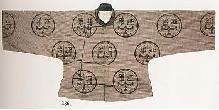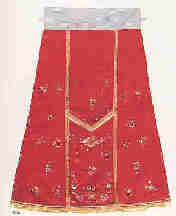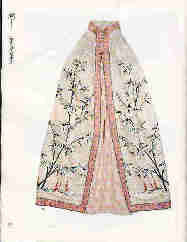Ma Gua

Ma Gua was an outdoor jacket to keep warm. It was designed to have a short, baggy sleeves and above waist to enhance the mobility of horseback riding. It was initially used for the soldiers; therefore, it was also called Victory Gua. For a period, it was very fashionable among the wealthy to wear Ma Gua inside out showing the leather and fur.
Men wore thin Ma Gua made of cotton cloth in the summer, and warm cotton Chang Pao or fur-lined robe in the winter. Ma Gua with many different styles were mostly blue, purple, gray, or yellow; but men were not permitted to wear yellow Ma Gua unless it was awarded to them, since yellow is the imperial color.
Dress adornments

Besides the Chang Pao and Ma Gua, other dress adornments Beijingers wore were the manteau, cloak, Ao (jacket), Kan Jian (waistcoat), Dun Zi (vest), Du Dou (bellyband), and Zhu Yao (waistband).
Ao was made of silks, satins or cotton cloth, wadded with silk floss or cotton. Women usually wore bright pink, cerise, and peach-blow jackets.
The manteau was in fact a surcoat with buttons down the front, large sleeves, and low collar, usually worn over the Ao (jacket).
The cloak, originating from coir raincoat in ancient times, was usually made of brightly colored silks and satins embroidered with varied designs. It was very common for women to wear a cloak during wintertime. Some even were decorated with precious furs of foxes and lynxes.
Kan Jian, a collarless and sleeveless waistcoat with buttons down the front, was very popular among the old and young, and male and female. An exquisite Kan Jian over the Ao would make the woman more elegant and refined. Today, it usually refers to the third piece of a three-piece male business suit, to distinguish it from other types of vests.
Dun Zi was a kind of underwear, collarless and sleeveless. Unlike Kan Jian, it was shorter and more close-fitting, with buttons down the oxter (armpit).

Du Dou, the bellyband, was the most mysterious and charming member in traditional Chinese costumes and popular among children and women in old Beijing. The bellyband was very formfitting and simple, usually with bright colors of red and yellow and embroidery patterns of flowers and birds, fresh peaches, and lovely moppets, full of Chinese ethnical feature and the sense of decoration. It was generally square in shape, with the above angle cut away to turn into two angles linked with a cloth or silk strip. The left and right angles each had a strip. The bellyband could nicely girdle the waist when hanged from the neck and tied at the back. The feminine Du Dou now has regained its spirit and life.
The waistband, about 0.3 meters wide, was usually favored by the elders. The thick band could keep the waist from cold by girdling it, with buttons down the right and the left sides.
During the Qing period, women wore two-piece clothing: one being the Ao (jacket), and one being the Qun (skirt), and sometimes pants.
The Manchu females had a custom of wearing Qixie (Manchu shoes) and males wearing boots. Officials wore square-toed boots, and commoners wore pointed-toed boots. Materials of the boots include satin, woven silks, cloth and leather, and so on. The Manchu shoes for women had a piece of flat wood as the tread, called "flat-tread shoes." Usually, there were colorized brims or bead string patterns on both the upper and the vamp.










